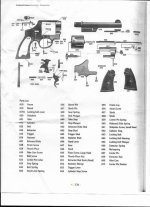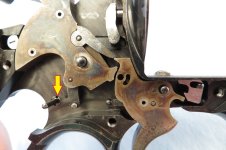I hope this isn't a redundant question. I couldn't find much with a forum search.
I would like to hear some ideas or opinions regarding the differences of the pre war vs. post war frame studs.
This is just based on my observations, and may not be correct, but...
On the pre war, it seems that the hammer, cylinder stop, trigger and rebound slide studs go through the frame and are visible on the left hand side. It seems that varying numbers may be proud or flush.
On the post war models, again if my understanding is correct, the studs are fitted to make their external appearance virtually invisible.
Does one method have any advantages?
I see from an exploded view diagram for a pre war model that the four studs are each listed as individual parts with their own number.
Does this mean that the studs on the pre war models are more readily replaced or repaired if damaged or broken?
A recent thread in the gunsmithing sub-forum illustrated some of the inherent difficulties of dealing with a post war broken stud.
Thanks for your thoughts.
I would like to hear some ideas or opinions regarding the differences of the pre war vs. post war frame studs.
This is just based on my observations, and may not be correct, but...
On the pre war, it seems that the hammer, cylinder stop, trigger and rebound slide studs go through the frame and are visible on the left hand side. It seems that varying numbers may be proud or flush.
On the post war models, again if my understanding is correct, the studs are fitted to make their external appearance virtually invisible.
Does one method have any advantages?
I see from an exploded view diagram for a pre war model that the four studs are each listed as individual parts with their own number.
Does this mean that the studs on the pre war models are more readily replaced or repaired if damaged or broken?
A recent thread in the gunsmithing sub-forum illustrated some of the inherent difficulties of dealing with a post war broken stud.
Thanks for your thoughts.
Attachments
Last edited:


